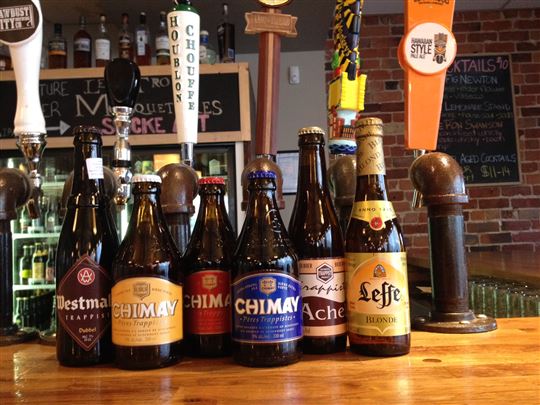Trappist & Abbey Ales: Part II
 Let’s explore some of the ‘classic’ styles and characteristics of both Trappist and Abbey ales. There is a multitude of diversity amongst these highly respected beers, and there are no absolute cookie-cutter traits of each. This is precisely why it is so satisfying to ‘study’ these elaborate ales. By ‘study’, I mean drink!
Let’s explore some of the ‘classic’ styles and characteristics of both Trappist and Abbey ales. There is a multitude of diversity amongst these highly respected beers, and there are no absolute cookie-cutter traits of each. This is precisely why it is so satisfying to ‘study’ these elaborate ales. By ‘study’, I mean drink!
Some are sweet, but many are dry. Some are as deep and dark as the monastery walls, while others are golden bright like the sun (any reminiscing of summer right now will help us get through the long winter here in the nation’s capital- bare with me!).
Despite the stylistic variations of both Abbey and Trappist ales, some hold a few commonalities in terms of their brewing process. Both are warm top-fermenting ales, while some share the same yeast strains giving them their unmistakeably spicy, fruity ‘Belgian yeast’ character. Authentic Trappist beers are unpasteurized without chemical additives or preservatives and are almost always bottle conditioned.
Generally speaking, these ales tend to be on the stronger side with their alcohol content usually averaging between 6%-9% abv. While you may be persuaded by the beer’s shade to determine alcoholic strength, in this case- don’t; darker doesn’t necessarily mean stronger. Nor does it suggest that it will have a roastier malt characteristic to it. The deep brunette hues actually come from the candy sugar added during the fermentation process, with the intention of caramelizing of the sugars for depth and richness (for you fellow wino ‘cork dorks’ out there, this is similar to the concept of ‘chapitalization’).
Let’s talk about the two classic styles of both Trappist and Abbey beers: dubbel and tripel, with the expectation that these two categories feature a broad range of intricate qualities, and are not always redundant nor predictable with their flavours.
The theory behind their names dates back to the Middle Ages- a time when many people were illiterate. It was assumed that the barrels holding these rich and delicious brews may have read something like “XX” (assuming dubbel, or ‘double’) and “XXX” (for tripel, or ‘triple’). The terms themselves identify with the brewing process and refer to the amount of malt with fermentable sugars.
Beginning with dubbel, this popular Belgian Trappist and/or Abbey style ale commonly pours a dark, russet brown and usually hovers around 6%-7% abv. Technically speaking, these ales are considered ‘dry’ despite sweet caramel, toffee, chocolate, rum, raisins and other rich dark dried fruits often dominating the palate. Bitterness tends to be on the moderate to low side, while carbonation typically resides on the higher side- which makes matching food with these dark beauties, well…FUN! Anything seared, fried or grilled (especially gamey red meats such as LAMB) pair perfectly with the dark caramel flavours. The high carbonation assists in resetting the palate from any fattiness (think crispy duck skin, and try not to gnaw off your own arm with your hunger!). Even better, classic fruit sauces accompanying these rich meats practically mirror the flavour components in the beers themselves. Don’t stop there though, try chasing down your steaks or beef stews and expect that you won’t be disappointed these beers can hold their own with rich, meaty dishes.
Tripels were historically pioneered by the Trappists of Westmalle. They can be some of the most beautifully complex styles of beer in the world- which make them extremely versatile when it comes to pairing with food. Typically, these strong ales pour a deep burnished gold while their alcohol content generally weighs in around 7%-10% abv (leaning towards the latter side more often than not). The best examples will showcase a sweet, malty fruitiness on the palate despite low residual sugar. Their herbal character, up front fruitiness and firm yet well-integrated hop bitterness make them stellar matches for sausages (especially brautwurst!). The classic dish wiener schnitzel with its herb crusted veal (are you hungry yet?!) also pairs beautifully with these fine golden ales. Any kind of fried or oily fish (fish and chips?) will also marry nicely, and once again your palate will be refreshed of any fatty-goodness, ready for the next bite!
This is the part of the blog where you’re supposed to be salivating and anxious to test out these ‘theoritical’ matches. Please don’t let me stop you! I’m here to help.
After these two main styles of Trappist and Abbey ales, things may start to get a little confusing (not because you’ve had one too many, or maybe you have? We’re not here to judge). Some examples are stronger, more intensified versions of the ‘classics’ and may be vaguely referred to ‘Belgian strong ales’- and may not necessarily be native to Belgium.
You might encounter a style called ‘quadrupel’– commonly reaching up to 14% abv (not what beer geeks would call a ‘session ale’ due to its high alcoholic content). These styles are rarely Belgian producers, and are more likely to be well received by the North American beer enthusiast.
What to do?
Read Part 1 of Trappist & Abbey Ales
Written by Kristin Perrin
Originally posted for Brother Bistro Blog
References: The Oxford Companion to Beer, by: Garrett Oliver, At The Brewmasters Table, by: Garrett Oliver

Trackbacks/Pingbacks
[…] November 19, 2013, Kristin Perrin in Kippy Also Sips Beer Leave a comment “Shhhh…..You Had Me at [Wine!]” #Barley Wine Trappist & Abbey Ales: Part II […]